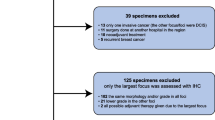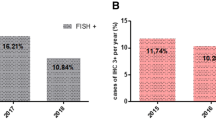Abstract
Purpose of Review
Breast cancer is now recognized to be a very heterogeneous disease. This complexity was recently reflected in the newest American Joint Committee on Cancer (AJCC) breast cancer staging, implemented in 2018. Although it seems very daunting, the new staging is based on both the anatomical extent of the disease and the prognostic factors such as hormonal and HER2 status, grade of the tumor, and genomic assays providing information regarding risk of recurrence. The purpose of this review is to illustrate the reasoning for the change in previous, solely an anatomically based breast cancer staging system and to report the updates.
Recent Findings
The research showed that evaluation of breast cancer through immunohistochemistry and utility of genomic assays provides substantial prognostic information.
Summary
The combination of anatomic and prognostic factors has a tremendous impact on outcome predictive abilities of the staging system for each affected individual.

Similar content being viewed by others
References
Papers of particular interest, published recently, have been highlighted as: • Of importance •• Of major importance
•• Hortobagyi G, et al. Breast AJCC cancer staging manual. In: American College of Surgeons (ACS) Chicago Illinois 2017. 8th ed. This is the breast chapter published by AJCC and addressing all the updates in the eighth edition of the breast cancer staging.
• Giuliano A, et al. Breast cancer-major changes in the American Joint Committee on Cancer eighth edition cancer staging manual. Ca Cancer J Clin. 2017. https://doi.org/10.3322/caac.21393. This is the editorial summary of the eighth edition AJCC breast cancer staging changes.
Polyak K. Heterogeneity in breast cancer. J Clin Invest. 2011;121:10–3788. https://doi.org/10.1172/JCI60534.
Parker JS, et al. Supervised risk predictor of breast cancer based on intrinsic subtypes. J Clin Oncol. 2009;27(8):1160–7. https://doi.org/10.1200/JCO.2008.18.1370.
Gautam M, et al. Histological, molecular and functional subtypes of breast cancers. Cancer Biol Ther. 2010;10:955–60. https://doi.org/10.4161/cbt.10.10.13879.
Goldhirsch A, et al. Strategies for subtypes—dealing with the diversity of breast cancer: highlights of the St Gallen International Expert Consensus on the Primary Therapy of Early Breast Cancer 2011. Ann Oncol. 2011;22(8):1736–47. https://doi.org/10.1093/annonc/mdr304.
Hon JDC, et al. Breast cancer molecular subtypes: from TNBC to QNBC. American Journal of Cancer Research. 2016;6(9):1864–72.
Russnes H, et al. Breast cancer molecular stratification. From intrinsic subtypes to integrative clusters. Am J Pathol. 2017;187(10):2152–62. https://doi.org/10.1016/j.ajpath.2017.04.022.
Dias K, Dvorkin-Gheva A, Hallett RM, Wu Y, Hassell J, Pond GR, et al. Claudin-low breast cancer; clinical & pathological characteristics. PLoS One. 2017;12:1. https://doi.org/10.1371/journal.pone.0168669.
Perou CM. Molecular stratification of triple-negative breast cancers. Oncologist. 2011;16:61–70. https://doi.org/10.1634/theoncologist.2011-S1-61.
Lehmann B, et al. Identification of human triple-negative breast cancer subtypes and preclinical models for selection of targeted therapies. J Clin Invest. 2011;121(7):2750–67. https://doi.org/10.1172/JCI45014.
Stemmer S, et al. Clinical outcomes in ER+ HER2 -node-positive breast cancer patients who were treated according to the recurrence score results: evidence from a large prospectively designed registry. NPJ Breast Cancer. 2017;3:32. https://doi.org/10.1038/s41523-017-0033-7.
Paik S, et al. Gene expression and benefit of chemotherapy in women with node-negative, estrogen receptor-positive breast cancer. J Clin Oncol. 2006;24:3726–34. https://doi.org/10.1200/JCO.2005.04.7985.
Morrow PK, Theriault R. Chapter 82. General NCCN guidelines. In: Kuerer HM, editor. Kuerer’s breast surgical oncology. New York, NY: McGraw-Hill; 2010.
Cardoso F, et al. The MINDACT trial: the first prospective clinical validation of a genomic tool. Mol Oncol. 2010;1(3 (2007)):246–51. https://doi.org/10.1016/j.molonc.2007.10.004.
Whitworth P, et al. Chemosensitivity and endocrine sensitivity in clinical luminal breast cancer patients in the prospective Neoadjuvant Breast Registry Symphony Trial (NBRST) predicted by molecular subtyping. Ann Surg Oncol. 2017;24:669–75. https://doi.org/10.1245/s10434-016-5600-x.
Cardoso F, et al. 70-gene signature as an aid to treatment decisions in early-stage breast cancer. N Engl J Med. 2016;375(8):717–29. https://doi.org/10.1056/NEJMoa1602253.
Author information
Authors and Affiliations
Corresponding author
Ethics declarations
Conflict of Interest
The author declares that there are no conflicts of interest.
Human and Animal Rights and Informed Consent
This article does not contain any studies with human or animal subjects performed by the author.
Additional information
Publisher’s Note
Springer Nature remains neutral with regard to jurisdictional claims in published maps and institutional affiliations.
This article is part of the Topical Collection on Local-Regional Evaluation and Therapy
Rights and permissions
About this article
Cite this article
Dombrowska, A. Pathology Meets Biology: the New Era of Breast Cancer Staging. Curr Breast Cancer Rep 11, 185–189 (2019). https://doi.org/10.1007/s12609-019-00325-3
Published:
Issue Date:
DOI: https://doi.org/10.1007/s12609-019-00325-3




